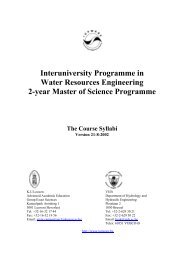CFHT operating manual - Homepage Usask
CFHT operating manual - Homepage Usask
CFHT operating manual - Homepage Usask
Create successful ePaper yourself
Turn your PDF publications into a flip-book with our unique Google optimized e-Paper software.
<strong>CFHT</strong> Observatory Manual - Observatory (Sec.5) http://www.cfht.hawaii.edu/Instruments/ObservatoryManual/CFH...<br />
To accommodate the changes in focal length of the telescope with<br />
temperature, and the focus position changes induced by the various<br />
filters, the camera must be able to move along the optical axis of the<br />
telescope. The focus stage assembly (FSA) accommodates this motion,<br />
supporting the camera and its shutter on a motorized stage bolted on top<br />
of the upper end platform. In order to follow the apparent motion of the<br />
sky due to the Earth’s rotation, two small cameras fix on stars outside of<br />
the field of view, providing automatic guidance of the telescope and<br />
measurements of the focal changes.<br />
MegaCam<br />
At the heart of MegaPrime is MegaCam, a unique camera built by the<br />
"Département d’Astrophysique, de Physique des Particules, de Physique<br />
Nucléaire et de l’Instrumentation Associée" at the French<br />
"Commissariat à l’Energie Atomique" (CEA). In addition to a cryostat<br />
housing the mosaic, and its cryogenics system to maintain it cold, CEA<br />
built the camera shutter, the filter jukebox and the electronics to acquire<br />
the image and send it to a computer through fiber optics cables.<br />
AOB/PUEO with KIR<br />
The Adaptive Optics Bonnette (AOB), also called PUEO after the sharp vision<br />
Hawaiian owl, was developed for the Canada-France-Hawaii Telescope, based on<br />
F.Roddier’s curvature concept. The ‘‘bonnette’’ (adaptor) is a facility instrument<br />
mounted at the f/8 Cassegrain focus of the CFH 3.6 m telescope on top of Mauna Kea<br />
(Hawaii). The instrument is the result of a collaborative effort between several<br />
institutes : The <strong>CFHT</strong> (managing the project and designing the general user<br />
interface); The Dominion Astrophysical Observatory (Canada) who designed and<br />
fabricated the opto-mechanical bench, the curvature wavefront sensor and its<br />
electronics; the company Cilas (France) who provided the deformable curvature<br />
mirror and the Real Time Computer and software, including a high level maintenance<br />
interface; the Observatoire de Paris-Meudon (France) who manufactured the separate<br />
tip-tilt mirror and was in charge with the final integration, testing and calibration of<br />
the instrument. The UH adaptive optics team provided guidance throughout the<br />
project. The system was commissioned at <strong>CFHT</strong> during three runs in the first<br />
semester 1996.<br />
KIR is a high resolution 1024 x 1024 near-infrared camera based on the Rockwell<br />
Science Center HAWAII (HgCdTe Astronomical Wide Area Infrared Imaging) focal<br />
plane array. This array is sensitive to radiation from 0.7 to 2.5 microns. KIR has been<br />
designed to be used at the F/20 output focus of PUEO, the <strong>CFHT</strong> Adaptive Optics<br />
Bonnette (AOB). It consists in an LN2 cryostat which harbors the detector, the fixed<br />
0.67:1.0 transfer optics, an F/20 cold stop and a filter wheel. The standard I, J, H, K<br />
and K’ broad-band filters are available, as well as several narrow-band filters. A<br />
preamplifier and a shutter are mounted externally to the dewar. The system is driven<br />
by an SDSU/Leach CCD controller which is the controller commonly used at <strong>CFHT</strong><br />
for all visible and infrared detectors. The system provides the observers with a user<br />
interface , called DetI, incorporated into the <strong>CFHT</strong>/Pegasus observing environment,<br />
through which they will configure the camera, control the data acquisition, monitor<br />
the data storage and do some pre-processing.<br />
The Dewar has been constructed by the Universite de Montreal, part of the array DSP<br />
code by the Observatoire Midi-Pyrenees. The acquisition system and software were<br />
under the responsability of <strong>CFHT</strong>. The final integration of the science grade detector<br />
has been carried out at <strong>CFHT</strong>. The first light has been obtained during the first<br />
5 of 10 08/07/04 11:26 PM

















